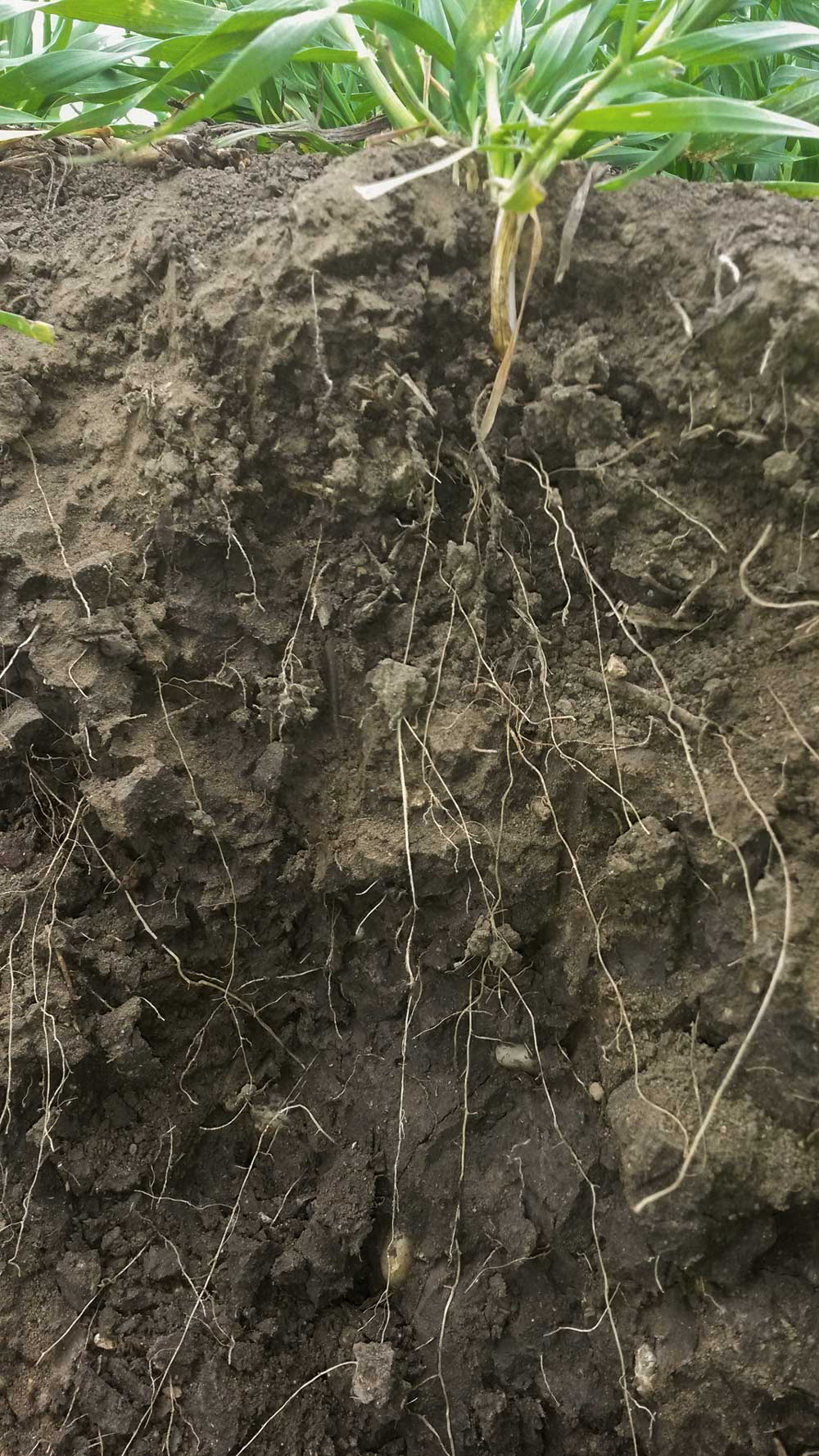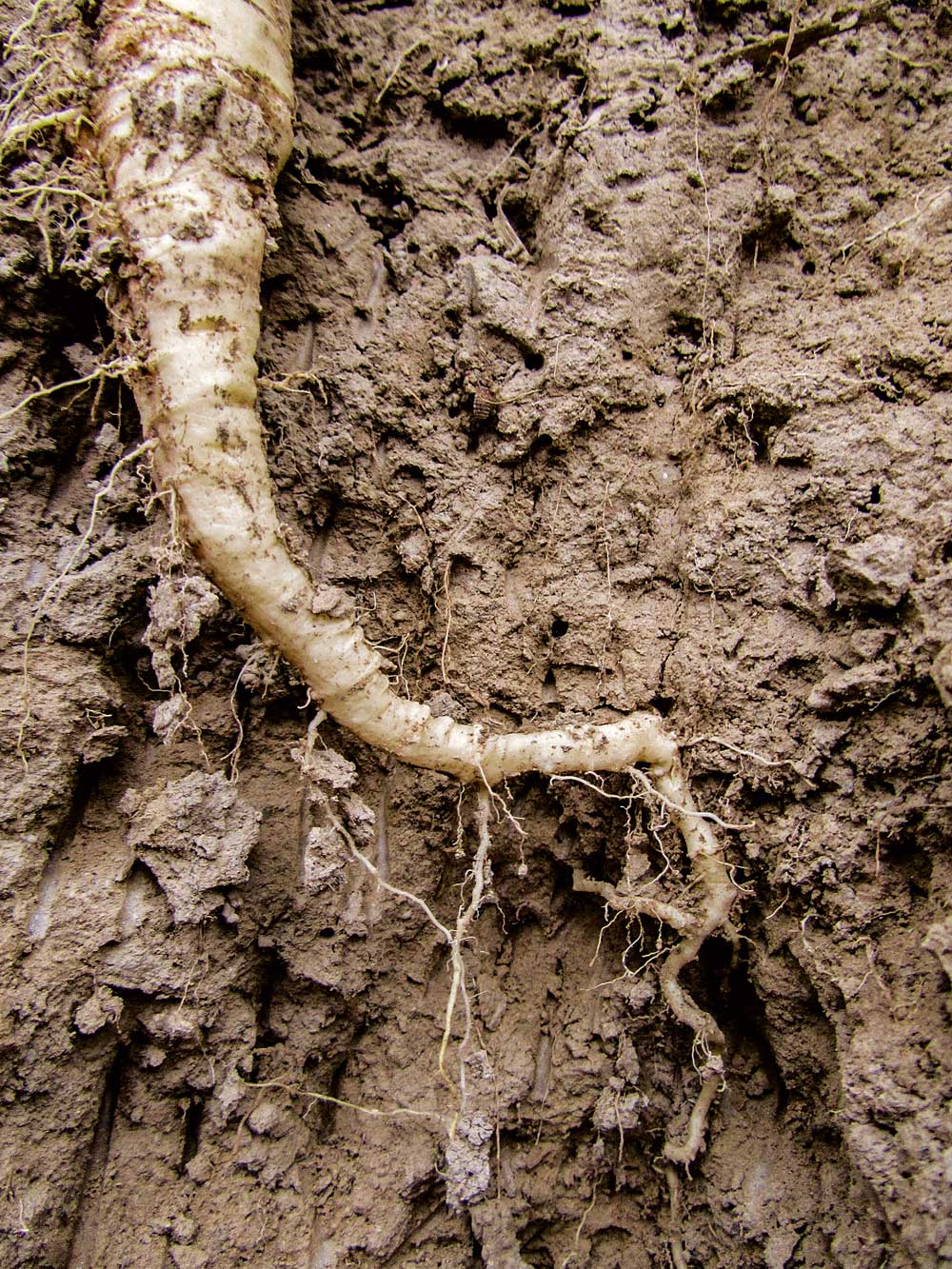Increasing yields: Top crop experts on rooting
By Christian Bickert and Katrin Rutt
There’s not much we can do about the soil we work with. But is that really so? Or can we perhaps make substantial changes on our fields through cultivations and crop growing methods? And what’s the best way to start? DLG-Mitteilungen discussed these questions with farmers from all over Germany as well as scientists, plant breeders and machinery experts from the firm Kuhn. The result can be summarised in six themes.
Soil texture cannot be altered - but its structure and fertility can be improved
Soil type and associated texture classification are predetermined and unchangeable. These determine the porous storage space for moisture and nutrients as well as nutrient sorption capacity. Nor can subsoil be broken up by the action of roots. Even tap roots find their way downwards via natural openings, be they biotic or abiotic.
On the other hand, the biological soil fertility is above all determined through roots, fungal hyphae, organic macromolecules and the microtexture bound by them (the biological soil activity). And here we can achieve a lot through organic manure application, intercropping, liming and naturally applying suitable soil cultivation methods. Avoiding compaction, working the soil as little as possible and giving the soil organisms nutrition through intercrops: all these actions belong to the fundamentals of long-term soil improvement. Hereby, the aim should always be to increase the rooting area or rhizosphere and so enlarge storage areas for moisture and nutrients. We’re talking here of substantial investment, whereby many years may pass in some cases before the effects are apparent. This means the subject receives less consideration by farmers on rented hectares compared with owner occupied fields, or those cultivated under long term secure tenancies.

Photo: Katrin Rutt
The amount fo moisture is difficult to influence - nutrient availability can be improved
Humus content is seen as a key for improving soil moisture holding capacity. However, long term trials indicate the effect is very limited. Dr Gernot Bodner from the University of Natural Resources and Life Sciences in Vienna estimates this at a maximum of 1% of the usable field capacity. But improving soil structure does indeed increase moisture uptake capacity with humus content improving root development and, with that, plant access to moisture reserves in the subsoil. On top of this, good soil biological activity facilitates an increase in nutrient availability, even during dry periods. Hereby, the influence is less from the mass flow of passively stored nutrients such as nitrogen and sulphur and more from their ease of availability. Large amounts of phosphorus are present in the soil and microorganisms help to release this element and make it available in the plant rhizosphere. The influence in concrete terms that organic manure application has on soil structure and its microbiology has so far not been absolutely explained. Certainly, differences can be expected in efficacy of different organic manures, for instance between straw-rich farmyard manure and livestock slurry.
Intercrops are over-estimated, at least as far as humus production is concerned
Sounds provocative, doesn’t it? But humus content is increased only by about 0.5%, even where intercropping is continual. And it is also a fact that intercropping is seldom able to break-up any soil compaction layers, according to Professor Dr Carola Pekrun from Nürtingen-Geislingen University (HfWU). Mechanically loosened soil tends to be more easily stabilised. The advantages of intercrops lie less in increased humus content and soil loosening and much more in improving nutrient availability through emission of root exudates and stimulation of the soil microbiology, not forgetting intercropping’s role in reducing soil nutrient leaching through the winter. Nutrient supply is therefore very much less influenced by lack of moisture than it is by mineral supply of nutrients.
Also by no means unimportant for root development and managing the moisture household is mulching field surfaces with straw or other materials. This not only helps avoid evaporation, which represents, according to Dr Peter Gernandt from Göttingen University, average losses of 4 l/day during the vegetation period in our climate zone, losses that easily rise to 10 l/day during very warm days. But above all, organic material on the field surface offers food supply for rainworms, the burrows of which represent more opportunities for a rapid water infiltration into the soil.
Which intercrop is best?
- Legumes such as peas or clover types are regarded as the best plants for intercropping. They unite the fixing of air nitrogen in the plant and good uptake of phosphorus from the soil.
- Crops of the knotweed (Polygonaceae) family (e.g. buckwheat) usually have a less than ideal biomass development for sustainable improvement of soil structure or for adjusting soil biological activity.
- With cruciferous crops, e.g. types of cabbage or kale, there’s often a problem for the rotation because those offer fungi and nematodes further intermediate hosts and can therefore increase disease pressure in the maincrop.
- While grasses produce enough biomass and root growth, mineralisation of residual crop material is slow and biomass nutrient content modest.
Good soil aeration is crucial
Absolutely necessary for a rapid start for seedlings and good rooting development is sufficient aeration of the soil. In heavy soils and under wet climatic conditions with substantially more than 600 l precipitation per annum, the plough or chisel tines are certainly the better choice for achieving sufficient aeration. In the long term, liming and soil biological activity enhancement, rainworms and other soil organisms can ensure the same.
However, following a wet potato, maize or beet harvest with associated heavy rutting of the field surface, deep grubbing or ploughing may be the only answer. But drying out operations on fields should be conducted with respect for soil structure. Where drainage is not present, or not functioning, repeated shallow cultivations with no clods left on the surface offers the best way ahead. These actions encourage aeration, at least in the surface vicinity. What to avoid here is underground compaction by using too heavy machinery or wrong tyres.
On drier locations even more effective are conservation cultivation methods and leaving natural evaporation to reduce moisture content. Where there’s only 500 l precipitation in the year, this action almost always ensures sufficient aeration.
Aeration is important not only for mineralisation and air access to roots but also for warming-up the soil. Well-aerated soil warms up quicker, with subsequent earlier release of nutrients in spring. KWS trials show that, in a warm spring, an underfoot dunging resulted in no extra growth but proved to have a very good effect in a cold spring.
Especially quick-starting spring crops such as beet or maize require a lot of phosphorus even quite early on but do not have enough root development to access this in the rhizosphere. The necessarily high nutrient concentration on the few roots present can therefore be secured either through applying the required amounts through fertiliser, or via intensive mineralisation (i.e. via aeration).
Soil cultivations release substantial amounts of nutrients
Here’s where differing interests clash. On the one hand, an intensive mechanical treatment of the soil following the cereal harvest supresses weed growth and volunteer cereal or oilseed plants. On the other hand, such operations encourage mineralisation with accompanying humus decomposition in the cultivation horizon resulting in large amounts of nutrients being released. Naturally, nitrogen is the major nutrient set free in this context, representing an advantage for following autumn-drilled crops, all the more so as fertiliser application for such crops is already greatly limited and will possibly be even more so in future. Winter cereals and oilseed rape can thus develop faster.
Depending on rainfall, such released nutrients are, however, also washed out, or large amounts of nitrogen and sulphur ending up stored in deeper soil layers. Hereby, it is again shown that the present discussion on a more stringent German Fertiliser Ordinance (DüVO) and the limiting of glyphosate applications can have many different interactions.




